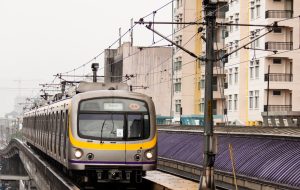Pacific Money | Economy | Southeast Asia
The ADB and JICA are currently funding extensive upgrades to the country’s railways and urban mass transit systems.

A light rail transit line in Manila, Philippines.
Credit: Depositphotos
On June 9, the Asian Development Bank (ADB) approved up to $4.3 billion in loans for the southern leg of the Philippines’ gargantuan North–South Commuter Railway project. The railway line is being constructed in three segments and will span a total length of 147 kilometers. It will start in the north near Clark International Airport and then run down through the urban core of Manila before continuing on to its southern terminus in Calamba. This follows on the ADB’s approval of a $2.75 billion loan in 2019 for the northern segment which is currently under construction.
The total cost for just the north and south segments will be $14.2 billion, of which the ADB has agreed to cover about half through loans, with the Japan International Cooperation Agency (JICA) picking up another $3.68 billion. Separately, JICA is financing the construction of the middle section that will connect Tutuban to Mololos. The scale of this project is enormous and, according to the ADB, represents the bank’s “largest infrastructure financing in the Asia and Pacific region to date.”
But this $14 billion mega railway project is only part of the story. One of the major economic policy programs during the Duterte administration has been increased infrastructure spending, and this includes Manila’s urban transit system, which is due for a big upgrade. For nearly two decades, mass transit in Manila was covered by three lines which have struggled with service and maintenance issues. Those lines are receiving upgrades and expansions, while two new lines, the MRT 4 and 7, have been approved or are under construction.
Even more ambitious is the Metro Manila Subway, a 355 billion peso ($6.3 billion at current exchange rates) mega-project being financed by JICA. Dubbed the “Project of the Century” it will represent a major upgrade to Manila’s urban transit system and is a fairly impressive engineering feat. Separately from that, the city government of the upscale Makati district has entered into an agreement with a private developer to build out its own subway system. The Makati project primarily involves Chinese financiers and construction companies.
Taken together, the commitment to investing in public transit infrastructure in metro Manila and its surroundings is real and the scale is very large. It echoes similarly ambitious public transit projects underway in Bangkok, Hanoi, Ho Chi Minh City, and Jakarta and it’s clear that there is a lot of construction and investment in the region aimed at the transit sector. But a few things jump out at me about how this is being rolled out in Manila.
First, almost all of these projects are being backed by the ADB or JICA. Outside of the Makati project, which is a local government initiative, China’s role is relatively small compared to that of Japan. This underscores the fact that while China’s Belt and Road Initiative often grabs the headlines, Japan’s footprint when it comes to infrastructure financing in the region may be less noticeable but is often more significant.
I think it’s also worth mentioning that big transit upgrades for Manila and its surroundings have been in some stage of planning and development for decades. At one point several years ago the government had signed contracts with Chinese counterparties to finance and build portions of the North–South Commuter Railway, but the deal fell apart and was cancelled.
The fact that these projects have moved forward and overcome numerous political, legal, logistical, and financial hurdles that waylaid previous attempts helps, I think, to explain why Duterte remained broadly popular with the Philippine electorate despite his well-chronicled shortcomings and controversies. His administration delivered on some big infrastructure projects where others failed.
The new president, Ferdinand Marcos Jr., would probably like his economic policies to be seen as a continuation of these efforts. But in a way Duterte did the easy part, by leveraging geostrategic competition between China and Japan during a time of loose monetary policy to get big projects financed. Marcos Jr. may find his role – bringing these huge and complex projects to completion while repaying the liabilities incurred to fund them at a time of high inflation and when global monetary conditions are tightening – a bit tougher.


